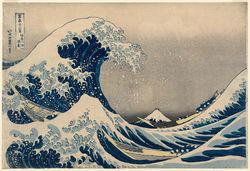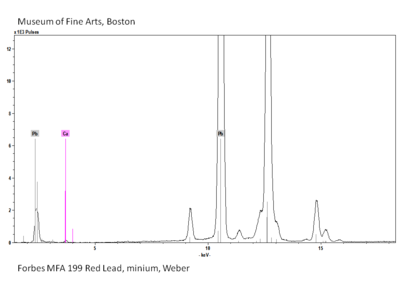Difference between revisions of "Category:Red lead: Ukiyo-e colorant"
| Line 4: | Line 4: | ||
<font size="3">'''[[Red lead]]'''</font> 鉛丹(''entan''): The common name for a heavy, opaque, orange-red pigment composed of [[lead tetroxide]]. Although chemically equivalent to the mineral minium, red lead has been synthetically prepared by roasting lead white (480 C) since before the 5th century BCE. Red lead and [[:Category:Lead white: Ukiyo-e colorant|lead white]] can discolor and darken when exposed to [[Hydrogen sulfide|hydrogen sulfide]]. | <font size="3">'''[[Red lead]]'''</font> 鉛丹(''entan''): The common name for a heavy, opaque, orange-red pigment composed of [[lead tetroxide]]. Although chemically equivalent to the mineral minium, red lead has been synthetically prepared by roasting lead white (480 C) since before the 5th century BCE. Red lead and [[:Category:Lead white: Ukiyo-e colorant|lead white]] can discolor and darken when exposed to [[Hydrogen sulfide|hydrogen sulfide]]. | ||
| − | Red lead has been continously used, as one of the first colorants to be used in early handcolored prints to printed red lead which can be a light pink orange to a reddish orange. (is the light pink orange, a mixture with white lead?) Like lead white, red lead also darkens with enivronmental exposure to hydrogen sulfide but it is thought that some red lead was intentionally darkened to create a dark metallic sheen. Acetic acid would be applied to the area and then exposed to hydrogen sulfide, mostly in the form of rotten eggs. | + | Red lead has been continously used, as one of the first colorants to be used in early handcolored prints to printed red lead which can be a light pink orange to a reddish orange. (is the light pink orange, a mixture with white lead?) Like lead white, red lead also darkens with enivronmental exposure to hydrogen sulfide but it is thought that some red lead was intentionally darkened to create a dark gray metallic sheen. Acetic acid would be applied to the area and then exposed to hydrogen sulfide, mostly in the form of rotten eggs. |
'''For more information see:''' [[Red lead]] | '''For more information see:''' [[Red lead]] | ||
Revision as of 19:17, 29 May 2020
Red lead 鉛丹(entan): The common name for a heavy, opaque, orange-red pigment composed of Lead tetroxide. Although chemically equivalent to the mineral minium, red lead has been synthetically prepared by roasting lead white (480 C) since before the 5th century BCE. Red lead and lead white can discolor and darken when exposed to Hydrogen sulfide.
Red lead has been continously used, as one of the first colorants to be used in early handcolored prints to printed red lead which can be a light pink orange to a reddish orange. (is the light pink orange, a mixture with white lead?) Like lead white, red lead also darkens with enivronmental exposure to hydrogen sulfide but it is thought that some red lead was intentionally darkened to create a dark gray metallic sheen. Acetic acid would be applied to the area and then exposed to hydrogen sulfide, mostly in the form of rotten eggs.
For more information see: Red lead
Examples of Red lead in Ukiyo-e Prints

|

|

|

|

|
Analysis
X-ray fluorescence analysis (XRF) is used to detect lead, which in a red or pink area, is an indication for the presence of red lead (Pb3O4).
Other Images of Red lead
List of Prints
List of prints where indigo was detected
Pages in category "Red lead: Ukiyo-e colorant"
The following 23 pages are in this category, out of 23 total.
H
- Harunobu, Ebisu and Ofuji, from the series The Seven Gods of Good Fortune in the Modern World, 34.343
- Harunobu, Nishikigi of the Kanaya Lighting Incense beside a Mosquito Net, 11.16479
- Harunobu, The Sake Cup, sheet 4 of the series Marriage in Brocade Prints, the Carriage of the Virtuous Woman, known as the Marriage series, 11.19475
- Hiroshige I/Hiroshige II, Ueno Yamashita, from the series One Hundred Famous Views of Edo, 11.35842
K
- Kiyomitsu I, Actor Ichikawa Yaozô I as Soga no Gorô Tokimune, 06.401
- Kiyomitsu I, Actor Segawa Kikunojô II as Seryômura Okiku, 11.18992
- Kiyonaga, Child Prodigy Minamoto no Shigeyuki Executing Calligraphy, 11.13883
- Koryusai, Descending Geese at Mimeguri, from the series Fashionable Eight Views of Edo, 11.14627
- Koryusai, Twilight Snow of the Bride, from the series Eight Views of Fashionable Human Relations, 11.19541
M
S
- Shigemasa, Bundle Tied with Straw; Calendar for 1815, 11.20149
- Shigenobu I, Puppy Playing with a Ball, 21.9257
- Shigenobu I, Urashima Tarô, from the series A Set of Five Examples of Longevity, 21.9254
- Shunkō, Actors Nakamura Nakazô I and Ôtani Hiroji III, 11.2014
- Shunshō, Actor Segawa Kikunojô III as Shirokiya Okoma, from the series Fans of the East, 11.14871
- Shunshō, No. 3, Comparative Poems, from the series Six Types of Waka Poetry as Described in the Preface of the Kokinshû, 11.19295
- Shunshō, No. 6, Cui Zongzhi (Saisôshi), from the series Eight Immortals of The Wine Cup, 11.14847





